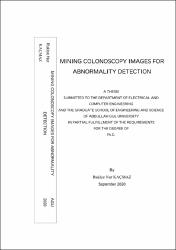| dc.description.abstract | Detection of colon abnormalities is one of the most challenging tasks for gastroenterologists. However, the frames or videos obtained during the procedure are exposed to significant amount of unwanted artifacts such as motion artifact, specular reflection (SR), improper contrast levels, gastric juice and bubbles, or residuals. The images with such artifacts are called non-informative frames. In the first study, we investigated the effect of SR and use of image interpolation to remove SR in texture-based automatic polyp detection. We tested whether nearest neighbors, bilinear and bicubic interpolation methods caused any differences in terms of texture features and classification performance to discriminate polyps from the colon background. In the second study the main aim was to compare the performance of conventional machine learning and transfer learning methodologies in detecting non-informative frames. In machine learning part, we used gray level co-occurrence matrix, gray level run length matrix, neighborhood gray tone difference matrix, focus measure operators and three first order statistics, and random forest, support vector machines and decision tree approaches were used in the classification phase. In transfer learning part, we employed deep neural network architectures like AlexNet, SqueezeNet, GoogleNet, ShuffleNet, ResNet-18, ResNet-50, NasNetMobile, and MobileNet. The last study included the detection of colon abnormalities such as Crohn’s, ulcerative colitis, cancer and polyp diseases on informative frames. The aim of this study was first to discriminate healthy frames from diseased ones, and to determine the disease types using both conventional machine learning and transfer learning approaches. | en_US |


















